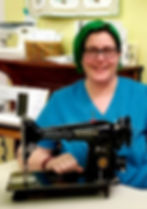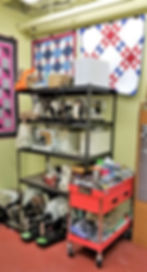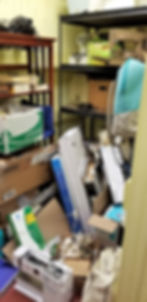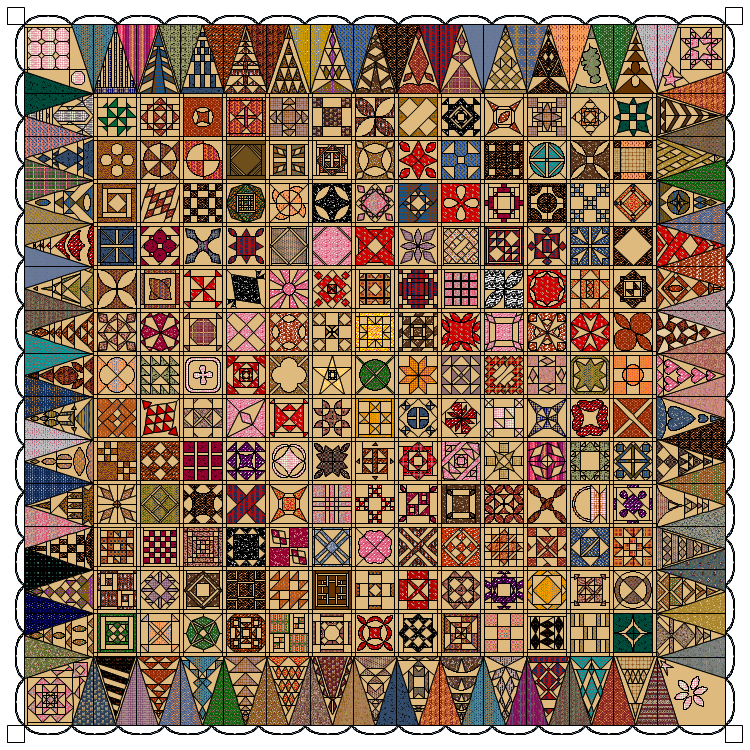Spring Clean Your Studio Blog Hop 2018!

Hi, Everyone! Welcome to my blog, the thin little thing that it is. It is still in it's humble beginnings, having to start over after a bot attack on my lost blog. Anyway, I am SO excited and SO honored to be a part of the #springcleanyourstudiobloghop2018, and a special thanks to Cheryl Sleboda at Muppin.com for the invite! I am co-owner of Red Hen Stitch Shop in Marietta, Georgia, and inside our quilt shop I also have a sewing machine service studio called Sewing Doc. Most people expect a grumpy old man, but what they get instead is my smiling face.

I'll admit, I feel a bit like a fish out of water with this one. I am coming up on 10 years of quilting (oh how I wish I'd know sooner that it was the missing piece in my life!), but also about 8 years in sewing machine service. I am thrilled that Cheryl was supportive in my idea of featuring my sewing machine service studio rather than my sewing studio... I'm sad to report the sewing studio gets very little use these days, but the machine service studio is in operation daily! I'll talk more about me and what I do in a bit. I wish I had better 'before' pictures, but I started overhauling the studio just before I became part of the blog hop. The timing couldn't be better! My humble little startup company is growing faster than I can keep up, and space is at a premium in my quilt shop. Here's a few pictures from 'before':



*Sigh* So what you see here is my main work area. The long workbench has two spaces, one on each side. I work on the right side, sometimes my husband, Paul, also my apprentice, works on the left side. On the shelf below the workbench, that's probably my biggest problem area. This is where I should be keeping things I need to get to on a regular basis, but instead, I just put everything there when there's room.
The one piece that needs to stay there is my beloved "California Air" compressor.

Behind me, when I'm standing at my work bench, are two sets of shelves. The shelves were an upgrade last year, and house the queue of machines waiting for service, repair, and restoration. As you can see, machines are still spilling over on to the floor. This really bothers me. I have a half-wall at my service counter so I can stay connected to my customers and still run the shop when I'm working. That means that customers can see into my work space. I can't imagine the view is pleasant.

Above, you'll see the second set of very-full shelves, and the table with the files and printer is also fairly new. I've been using that tiny stand up desk to do all my administrative work. The printer used to be over on the other side, so I put in a table to be more efficient. However, I could only use a 4-foot table due to space issues. This helped, but it is still too cramped.
Let's get into the really embarrassing stuff...

There are two closets right next to my work space. One is technically the base of the stairs that lead to the business upstairs, which has mostly been a janitorial closet and a place to cram stuff that doesn't have a home. That's actually a bit of an understatement.
The other is literally a small closet under the stairs. It's an odd shaped room, one that is also good for cramming stuff when in a hurry.
Actually, this is where my little business started when I became co-owner of the shop. Every machine that came in and went out used to fit on this one shelf that is now buried with... stuff.

On the other wall in this closet is another workbench that I mostly use when I have a machine that isn't cut and dry. They stay disassembled for a long period of time while we do research, find solutions, and basically fret over them (because mostly I cannot accept that some machines just cannot be brought back to life).
As you can see, this area is totally out of control. I also don't have a good place to store my office supplies and various papers, pamphlets, invoices for fabric, and whatever other shop things accumulate in my life. There are so, so many things. And really, most of it needs to hit the trash can.
I should also mention, the machines you see in this closet - the shelf, the floor, the workbench - are all donation machines. They are machines that have been abandoned mainly because they cannot or will not be repaired, and some of them were given to me rather than them going in a dumpster somewhere. They will eventually be disassembled so that we can reuse the parts. We waste as little as possible!

This last picture is in the actual shop office, which I did a huge clean of this last week before I knew about the Blog Hop. Believe it or not, this is a big improvement from what it was, but still not great. You see the 1 1/2 empty shelves on the left? I cleared that to start storing throw-away machines until I have some teenager/apprentice help to disassemble them.
The workbench there is a second one like the one in the closet. It used to have an apprentice to go with it, but times have changed and now it collects dead machines and one machine that is completely frozen and still in progress.
As I said, I wish I had more 'before' pictures, but I was already in progress when I signed on to the Blog Hop. Now let's get to the fun part!
I cannot tell you the number of hours of physical labor that went into turning this studio upside down. Most of the machines I service are vintage or antique, and that means pure, cast iron steel. Phew!


First, we have the ultra-clean workbench where we do most of our work. I am really guilt of keeping clutter on the right side of the bench where my computer is. People hand me messages, sticky notes, papers... they end up right there. So I'm really focusing on keeping that clean. Below the bench, you'll see lots of improvement. I thew out and relocated so much stuff. Unfortunately, the stuff below my side has to stay - those are bins of frequently used parts that are too large for the parts bin. I am working on purchasing a huge tool chest to store all of that, chemicals, supplies, parts, and tools. But at least now it makes sense.

This might be one of my favorite things in my studio. My Swiss Tools are something I treasure - my first set of real tools tailored to sewing machine repair, and I paid a lot of money for them. I'm afraid I will misplace them. In fact, just last week I broke the tip on one of them, and was happy that it was replaced and in my hand within 48 hours.
I struggle with how to store them so that they'll be easy to grab when I'm contorted and trying to hold a part in place with it's screw. What you see here is a butcher block that has a bunch of plastic strips in them. I believe it's called a "slotless butcher board". Whatever it is, it's been absolutely perfect for storing my screwdrivers. I'm considering a second one for other tools and picks, and now I think I might want one of scissors and other tools in my sewing studio.

The shelves are completely gone from my work area, which is a weird adjustment for me. I pulled both workbenches out and have them lining the back wall. They are are a short term solution, as I am adding another person to our shuffle in a few months, and I want a permanent structure. But these work great for now, and they are free! Paul and I use them for one, overflow, and two, preparation. He's only in the shop on Tuesdays and Sundays right now, so I pull out machines that have a specific repair (usually electrical), and they are lined up so he can maximize his time. This is what you see here. This is the only time I hope to see machines lined up here.

Looking down the workbench here, you can see the vast improvement having moved all of that out of there. The tall cabinet holds bobbins and small machine parts. It's not ideal, but it works until we figure out the long term solution. And look at that clean workbench and empty floor space!

On the other wall is the improved administrative space. I put in an 8 foot table which is heaven. I even have room to sit down and work on the rare occasion I get the chance.

This is everyone's favorite piece in my service studio. It's so hard to capture in a picture, but I am probably the ONLY machine service shop with a fancy chandelier. Before my service studio, we had an antique bed that displayed fabric and quilts, and this beautiful chandelier hung above it.
Then we built the wall and my work bench, and the chandelier stayed. I cannot imagine taking it down... it's such a stark contrast to the dirt and grime that is the rest of the studio!

This is one of my favorite pieces in my studio. This is my quilt shop co-owner, Brie, and I. For health reasons, she works from home, but she's always with me. We were certainly made for each other.

Remember the crazy shelves that were in the main work area? The space under the stairs is completely cleaned out (lots of dumpster and recycling action!), and three shelves now hold the queue of machines waiting for service, repair, and restoration. This level of organization is taking some getting used to.

This doesn't look like much, but this is sooo clean! This is the little table by my workbench that holds my other tools, cleaning supplies, and test sewing fabrics. This stays a mess. This is the part that will be replaced with a large tool chest on wheels.

And that space in the main office... holy cow. This was a real eye-opener. that 1 1/2 shelves I reserved for dead machines was filled up in no time. Thankfully I found another set of industrial shelves (after much cleaning!) and it is now filled with machines that need to be disassembled. Yes, with the exception of the machine on the table in front, ALL of those machines are dead and will be disassembled. The parts will be sold or stored for use on future machines.
Up top is an overflow of cleaning supplies, tools, and general items.

Not a great picture, but above you get a better idea of the full service studio. The short counter is the customer counter, and I struggle to keep it clean of machines (good problem to have!). The green doors now hold the queue of machines, and to the left of this pic is the small closet that now holds cleaning supplies, the shop vacuum and seasonal displays.

This is a common site in the shop. Every machine found in the wild here is a consignment machine. I have a very large inventory at the moment, but the treadles are our favorite to display. This is in front of my counter.
Behind the machines are samples of our applique line, MFEO (Made For Each Other).

This is my view to the left of my workbench. This pic was taken as we were setting up for shop hop, in our batiks section. I have to say, I can't feel anything but joy walking through our quilt shop.
So here's a little more about me. Soon after I started quilting, my husband bought me a 1957 Featherweight for my first Mother's Day. I was over the moon - not only to have a fabulous machine, but I also love old things. Soon after I took a class to learn how to service it myself, and I. Was. Hooked.

I started collecting old machines, then people caught wind of this, and they literally started showing up on my doorstep. At one time I had at least 93 sewing machines in my house. I know, I have a problem. I have more thread than fabric, and more machines than thread.

Back then my son was young, and I was doing a lot of commission quilt work for extra income, but I spent my "free" time studying machines, how they work, how to restore them. I started finding discarded vintage machines and bringing them back to life. It was exhilarating! And I discovered that I am way more mechanically geared than I ever imagined.
Word starting getting out that I was doing vintage and antique machine stuff, and I suddenly had customers coming to my home for service. I found out then that there aren't many independent shops left, and most dealers are not trained to handle old machines, nor do they want to. So a business was born.

In 2015, I became co-owner of Red Hen Stitch Shop and moved my little business into the shop full time. The demand for modern machines increased, and I found a couple of very nice gentlemen in Texas that helped me form those skills. So we became a full service studio.
Over the years I have noticed a huge gap in the industry - the old sewing machine guys (OSGs) are aging out - retiring, passing on, and leaving a huge gap. Dealers have a completely different business model, focusing only on the most current machines. Most won't touch a treadle for any amount of money.
I started doing Featherweight service workshops about 3 years ago, and it remains the shop's most popular class, followed closely by Freemotion Quilting for Beginners. This summer we are introducing the Vintage Machine Cleaning workshop, and then later this fall, we will hopefully launch our first certification class in vintage machine service.
We are looking to fill the gap. At this time, there is no way to learn sewing machine repair outside of YouTube/Google searching, being lucky enough to find a technician that will teach you (I can assure you, they don't have time or they simply won't), and there are a few people around the country that teach classes like I do. BUT, there is no certification. No trade school. No college course. Nothing of the sort. While we haven't made an official announcement yet, we are currently building a full-scale certification program in sewing machine service, repair, and restoration. It is our hope that small communities can have service centers, run by families and small businesses.

I am grateful everyday for the opportunities that this new adventure is giving us. My son is now 8, and we homeschool, so he's at he's hop with us a lot. He's a true southern boy, rarely wearing shoes, as you can see here. I think he'd come to the shop without pants if we let him!
I don't know that he'll ever take up sewing, or servicing machines for that matter, but the fact that he can be part of my service studio and watch us grow a business, that's priceless. I hope other families can have this experience, too.
Thank you for stopping in and sharing in our cleanup!
Be sure to visit the rest of the shops on the Blog Hop below!
April 27 - Misty Cole - http://www.mistycole.com/blog April 28 - Carolina Moore- http://alwaysexpectmoore.com/ April 29 - Heather Pregger - https://heatherquilts.blogspot.com/ April 30 - Linda Bratten - https://lindabcreative.blogspot.com/ May 1 - Lisa Reber - https://www.dippydye.blogspot.com/ May 2 - Teresa Coates - http://www.crinkledreams.com May 3 - Lisa Chin - http://www.lisachinartist.com/ May 4 - Jamie Fingal - http://www.jamiefingaldesigns.com/ May 5 - Sam Hunter - www.huntersdesignstudio.com May 6 - Jessee Maloney - www.artschooldropout.net/blog May 7 - Rhanda Parrish - http://www.sewartsyfartsy.com/ May 8 - Sarah Vedeler- https://meaningoflifedesigns.com/ May 9 - Jessica Darling - https://jessicakdarling.com/ May 10 - Melody Crust - http://www.melodycrust.com/ May 11 - Debby Brown - http://higheredhands.blogspot.com May 12 - Cheryl Sleboda - http://blog.muppin.com




